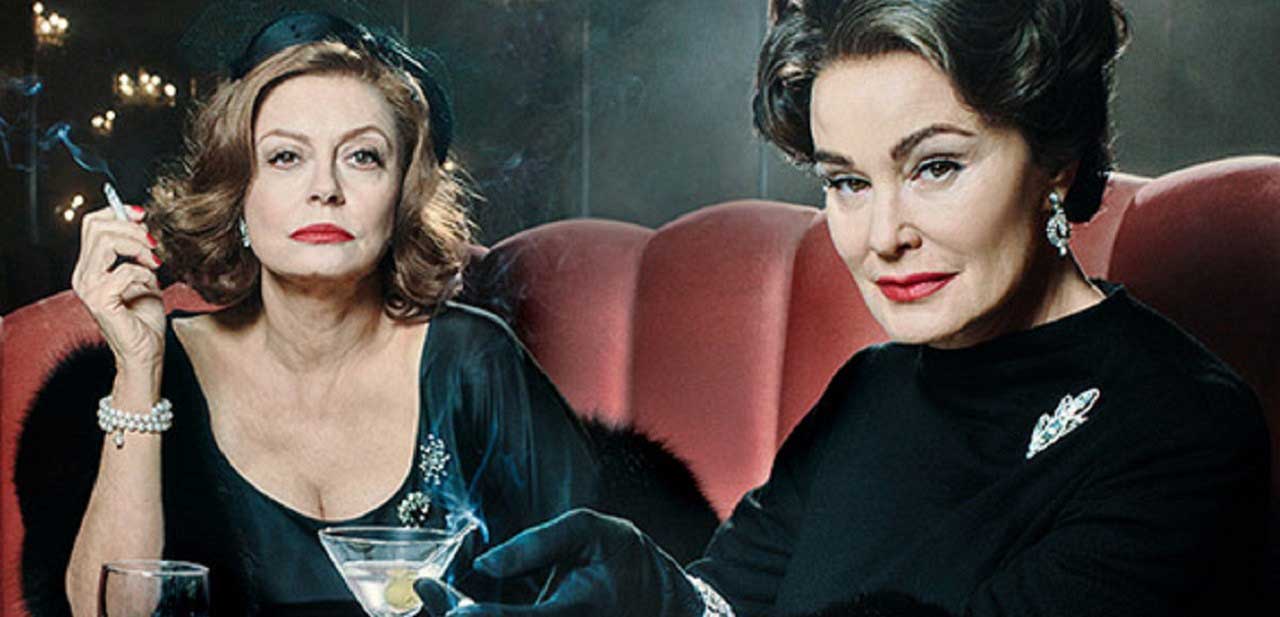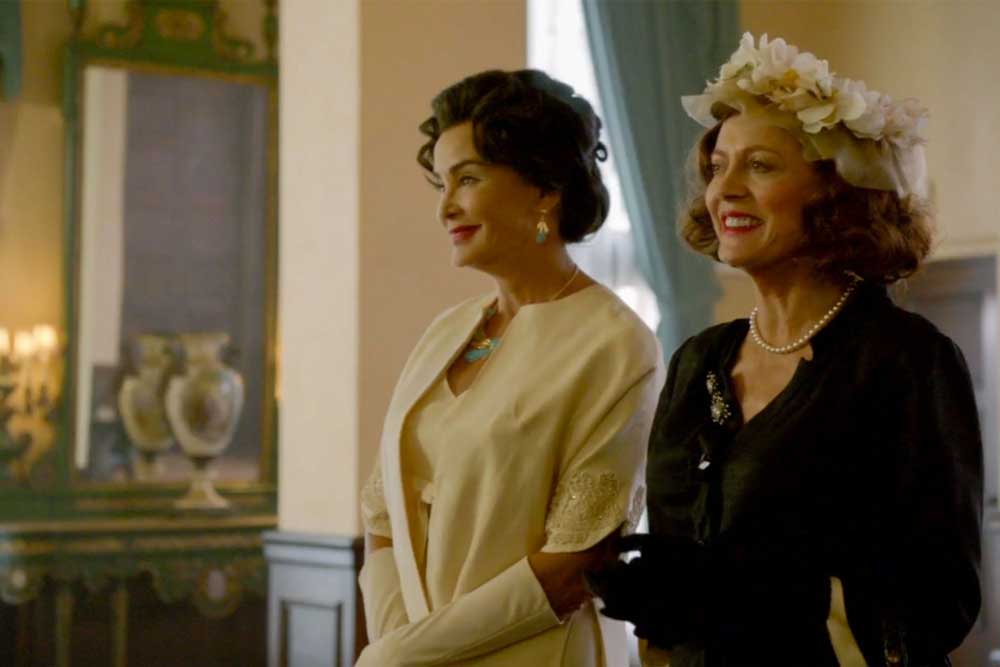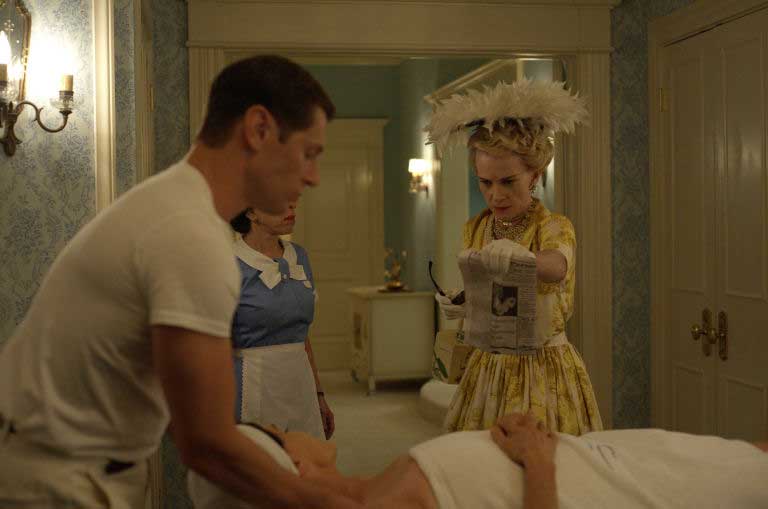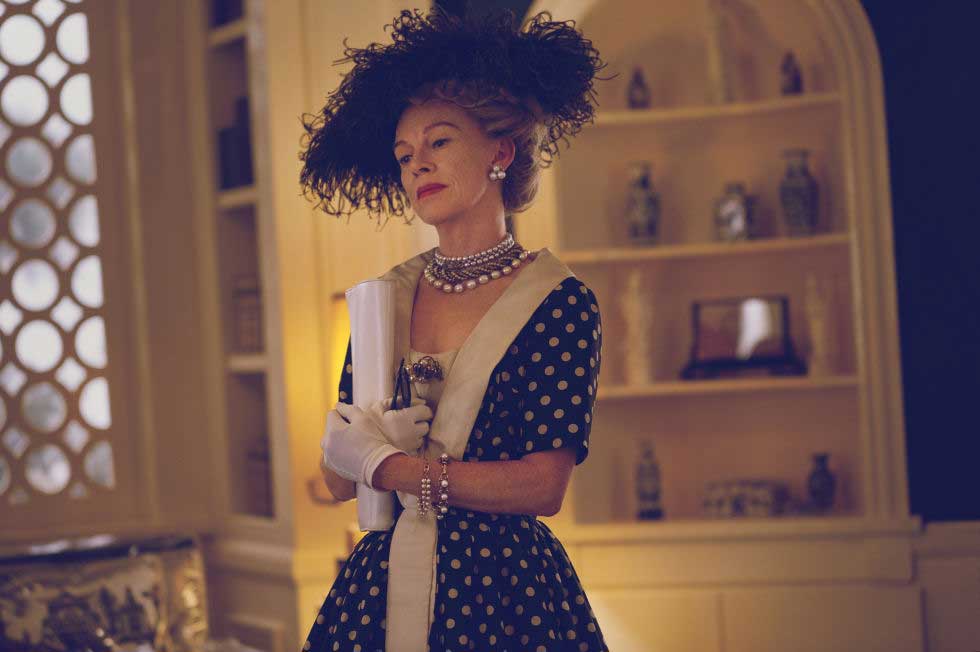Ryan Murphy, the creator of Glee and American Horror Story, is back with a new series on FX. Feud: Bette and Joan follows the story of Bette Davis and Joan Crawford while they film Whatever Happened to Baby Jane, a horror movie released in 1962. Starring Jessica Lange as Joan and Susan Sarandon as Bette, Feud confronts and explores ageism and sexism in a way I have never seen on TV before and I am LIVING for it. We can learn so much about the effects of body currency by watching this show.

Joan Crawford is obsessed with preventing aging in scene after scene. In the first episode her in-home aesthetician is hustling hard at softening and tightening the skin on her neck while telling Joan there’s nothing to be done about the neck, really. Joan is often staring in the mirror with disappointment, rushing out of the dailies for Baby Jane because she hates how the lighting reflects her visual age. Joan famously said, as is repeated in the show, that twin hazards of fame were alcoholism and loneliness and her alcoholism is very well featured on the show.
Bette Davis is not immune to the sexism and ageism in Hollywood, either. Much like Joan, acting roles were drying up for her because Hollywood studios weren’t producing movies for women their age. This is explained in back story how the two women who were famously feuding came to work on this film together. In the first episode Joan hunts through library books for a story that could be a script with a strong character for her.
 OUTFITS. I’m getting so many ideas for my fatshion bucket list for vintage looks to recreate from this show. Especially that dressing gown Joan wears on the set of Baby Jane. This show is my gender.
OUTFITS. I’m getting so many ideas for my fatshion bucket list for vintage looks to recreate from this show. Especially that dressing gown Joan wears on the set of Baby Jane. This show is my gender.
Joan Crawford’s grief at the aging process is made so much worse by her investment in a system of body currency. This term was coined by Jes Baker of The Militant Baker, and it describes the value placed on certain bodies based on oppressions and privileges. In our society, body size, ability, age, gender presentation, race and a whole slew of other variables receive a certain value. This is why a lot of fat hatred is rooted in fear—if people give up their body currency they will lose some sort of access to privilege, or they are constantly in fear themselves of getting fat and losing their privilege. But we can choose whether we are invested in this system or not, relieving ourselves from that constant source of terror. It’s helpful to remember that the system of body currency is something we are taught to keep us supporting the billion dollar diet and cosmetic industries who exploit the fear they create.
Joan is in agony over her age and her shifting career. I absolutely love that this show is on TV because it shows so beautifully the true cost of investment in this system in the long run and especially later in life (hello, we are all getting older).
 I’m obsessed with the set used for Joan Crawford’s house and love the sumptuous colors and saturated pastels and amazing wallpaper and draperies. This is the second aesthetician we see in her in home spa and I wonder if this is to indicate the first woman was fired because she said things Joan didn’t want to hear about the visual affects of aging?
I’m obsessed with the set used for Joan Crawford’s house and love the sumptuous colors and saturated pastels and amazing wallpaper and draperies. This is the second aesthetician we see in her in home spa and I wonder if this is to indicate the first woman was fired because she said things Joan didn’t want to hear about the visual affects of aging?
I think a lot about the effects of sexism and ageism on the women I admire. This includes my beloved Grandmother and my idol Dolly Parton. Grandmother cared very deeply about her looks. She was pretty broke in the earlier part of her life, especially as a single mother in the sixties. In those times her beauty was great currency.
She eventually found success as a real estate agent in Beverly Hills, where it’s all image all the time. Aging was hard on her. So was trusting other women. Especially given how many women accused her of sleeping with their husbands before she remarried, simply because she was beautiful and single–“This is what it was like in the sixties, Dear,” as she would say.
I look at Dolly Parton and how she hides more and more of her body, especially her hands. You’ll never see her without something over them. I like to think of it as the “more is more” approach to accessorizing that I prefer, but I always wonder if it is to hide the effects of aging on her hands.
 All of Hedda Hopper’s outfits in the show are more is more. I would be such a good mom to that feathery hat.
All of Hedda Hopper’s outfits in the show are more is more. I would be such a good mom to that feathery hat.
The men stirring the pot in the feud between Joan and Bette are relying on scarcity and body currency to create the tension between them. It works. Joan and Bette feel like they are fighting over the same few scraps: scripts featuring any roles for older women (few and far between), attention from men, money.
If Joan and Bette divested from body currency, they might be able to be bouyed by one another’s fabulousness. Whenever I’m around other babes who are babing to the max, I feel like more of a babe. I don’t feel overshadowed because I know there’s actually enough light to go around. But Joan and Bette certainly didn’t live like that.
I love that in the telling of the story for the TV show Ryan Murphy uses Olivia de Havilland and Joan Blondell, other actresses of their generation, in documentary interviews about the feud, creating a chorus of women who articulate the experience we see Bette and Joan going through. They talk about how there’s only one “it girl” at a time and how lonely it gets when the roles and attention dry up.
Because Joan Crawford is so invested in the system of body currency she is experiencing multiple, devastating losses. When you divest from the system of body currency, you do not lose when you age. You simply get older and enjoy life more, which ironically, has a pretty amazing effect on you at a cellular level. From what I have learned, the fountain of youth is to not give any fucks about aging.
 Ryan Murphy is openly gay so it doesn’t surprise that there’s a great gay subplot.
Ryan Murphy is openly gay so it doesn’t surprise that there’s a great gay subplot.
But you can’t ignore the foundation the patriarchy laid for this feud and there was and still is an actual scarcity of roles for older women actresses. This is where Ryan Murphy is not only doing great social justice work by confronting sexism and ageism in his new series—he is actively interrupting the sexism and ageism by writing a great script for some phenomenal actresses to shine bright. The whole series is sumptuous in its great writing, gorgeous sixties sets, outrageously beautiful clothing and fabulous women actresses. There is even an openly gay character showing what it’s like for gay actors pre-Stonewall.
I lament there is a complete lack of roles for people of color in the series and I definitely think he can do better in that regard. He picks up where Mad Men left off in many ways with the opening credits an homage to the Mad Men opener, attention to vintage detail and casting Kiernan Shipka in the role of B.D. Sherry (Bette’s daughter), whose presence makes you feel like it’s just the next chapter of Sally Draper’s life. In some ways he is using the neural pathways folks already have for Mad Men and other heavy attention to detail vintage series but I wish that more directors working with historical content were willing to use racially revisionist casting reflecting current values the way we see with Hamilton.
 So looks like it is a page ripped from Mad Men in the best ways. I miss that show!
So looks like it is a page ripped from Mad Men in the best ways. I miss that show!
Nonetheless, Ryan Murphy’s storytelling is fabulous. Even if you know most of the backstory for the show, the way he tells the story is the real delight. When you get to the end of Episode Four (which aired last night), just note the way he sets up the scene where Joan finds out about the Oscar nominations. It’s absolutely perfect.
Catch-up with Feud on demand as well as online with a cable subscriber login.
